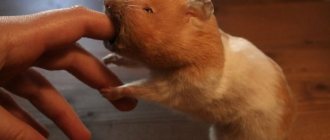November 18, 2021
More please: how to save money when traveling
Read November 16, 2021
Russia resumes flights with five countries it almost never flew to before
Read November 11, 2021
The authorities want to introduce QR codes for traveling around Russia. How will it work?
Read November 8, 2021
How to have fun in Goa
Read November 5, 2021
I love jokes like this: motivational stories about vaccine tourism
Read November 2, 2021
Why are flights delayed due to fog, and what should you do if your flight is also delayed?
Read
If you decide to fly with a tiny friend, you need to know the transportation rules. With small animals everything is more complicated than with cats and dogs. And spoiler alert: some disappointing news awaits you.
Almost all carriers are loyal to dogs and cats on board, but with small pets it is more difficult. For example, S7 does not allow the transport of rodents, fish, reptiles and arachnids. In general, not at all and under no circumstances.
S7 Airlines response
S7 Airlines can only transport cats, dogs and birds.
Therefore, before purchasing a ticket, check with the airline: you can or cannot carry it and what the conditions are. Agree on a solution with the carrier at least 48 hours before departure. And read the rules and tips for transporting animals.
How to transport rodents on an airplane
- Rodents are transported in certified factory containers.
- Some airlines reluctantly allow rodents on planes. In this case, the container must correspond to the dimensions of hand luggage. Check with the airline for size.
- It is necessary to provide documents from the veterinary clinic stating that the animal is healthy.
What documents are needed
- Veterinary passport
- Chipping mark
- Veterinary certificate form No. 1 - for domestic flights
- International veterinary certificate - for international flights
- Additional package of documents upon request of the country of arrival
- Check if your little one is on the Rosselkhoznadzor list. If there is, then everything is fine. If not, you will need to obtain an individual import/export permit
What kind of cage is needed?
With a dense frame, good ventilation, no sharp corners and a reliable lock. It must also fit within the dimensions of hand luggage.
More important information
Rodents are potentially dangerous guys for an airplane. The dog won’t just get lost on board and crawl into some crevice. But a hamster - easily.
Many companies refuse to transport rodents. If you decide to travel with a hamster, be sure to check all the information with the carrier.
In addition, even if you manage to take your pet out, it is not a fact that upon arrival in another country it will also be greeted happily. Find out what the specific country's import regulations are.
Under no circumstances should you try to transport your fluffy in secret. This is fraught with consequences, and if the hamster is found, it may have to be left at the airport.
Is it really impossible to do without carrying?
Special carriers and containers for hamsters are not a tribute to fashion, but a necessity that ensures the safety of the baby. Of course, if you buy a hamster and you need to bring it home from the market and you don’t plan to travel, you can use a jar. But if it breaks, the baby will suffer.
If you travel frequently, carrying your hamster's permanent home with you is inconvenient, so a carrier is necessary. It will ensure complete safety for the rodent. It is convenient for hamsters to travel in a small box; it is comfortable and warm. The stress from moving will be minimal, because everything necessary for life is available, in particular, food and drink.
How to transport birds by plane
It's easier with birds.
- Agree your decision with the airline at least 48 hours in advance.
- Take your veterinary passport.
- Get a medical certificate that Kesha is healthy.
- Buy a durable, factory-certified cage.
- Ask the airline about additional documents and, if necessary, collect them.
- Before check-in, take your bird to the veterinary control, which is located on the airport grounds.
What documents are needed
- Veterinary passport with chipping mark
- Veterinary certificate form No. 1 - for domestic flights
- International veterinary certificate - for international flights
- Additional package of documents upon request of the country of arrival
Check the list of additional documents with the air carrier and the consulate.
What kind of cage is needed?
With a dense frame, a waterproof bottom and a strong lock. The cage cannot be opened during the flight. It is possible to take a bird cage into your hand luggage, but it must comply with the dimensions set by the airline. Anything that doesn’t fit properly goes into the luggage compartment.
And be sure to check with the consulate of the country of arrival about the conditions for importing poultry.
We build a house according to the drawing
You can make a shelter for hamsters from cardboard according to the drawings. The assembly diagram for such a house is shown below.
A pet house can be made from different materials. It is necessary to take into account its safety and convenience for the animal. Almost any of the houses presented above can be adapted for both Djungarian and Syrian hamsters.
Previous Keeping hamstersCage for a Djungarian hamster, housing for a Djungarian hamster (photo) Next Keeping hamstersToilet for a hamster: how to equip and train your pet, how to make it yourself
How to transport fish on a plane
Flying with fish is also quite problematic. They happen to live in water, and usually the volume of liquid exceeds 100 ml. Therefore, we find out from the airline whether you and Flounder can fly. Then, as always, we clarify under what conditions it can be imported into another country.
Aeroflot's response
Fish and rodents are also on the list of animals that are not accepted for transportation as a special type of non-standard baggage. Our airline does not transport these types of animals either in the passenger cabin of the aircraft or in the luggage compartment.
General rules for flying with fish
- Be sure to coordinate your transportation with the airlines 48 hours before departure.
- Get confirmation from a veterinary clinic that the fish are healthy.
- The airline is not responsible for the fish.
- Most likely, the fish will fly in the cargo compartment of the plane.
What documents are needed
- Certificate from the veterinary service
- International veterinary certificate
- Sales receipt from the store
- Additional package of documents upon request
What kind of aquarium do you need?
A sealed container without sharp corners and with darkened walls. Or sealed multilayer bags.
Hamster house out of a box
Using the same principle as a wooden house, you can make a house out of a box.
To do this, we will prepare a “pattern” from cardboard. We connect the walls with glue that is harmless to the animal, and cut out the entrance and windows with a stationery knife or scissors.
You can go the very simple route by using a tissue box.
These boxes are convenient because they already have ready-made holes; they will serve as an entrance for the hamster. If you have a square box, you can simply cut it in two so that the cut line goes right down the middle of the napkin dispenser window. You will receive 2 identical houses for small animals. If the box is rectangular, you will have to make two cuts so that the future house has compact dimensions and stands stably in the cage.
Take the cardboard tube left over from the toilet paper and insert it into the opening of the box. Attach it to the edges of the hole with glue, secure it and let it dry. You have a house with a tunnel entrance.
How to transport reptiles and spiders on a plane
We have bad news for you: reptiles and spiders are officially banned in almost all companies.
Reply from Utair
This type of animal is not allowed to be carried in luggage or carry-on luggage. Only cats or dogs can be transported in hand luggage (subject to the conditions of carriage), cats, dogs or birds can be carried in luggage. All other animals, without exception, can only be transported as cargo.
To find out the conditions of transportation, you need to call the departure airport (phone numbers are on our website in the “Airport Help” section). Check the telephone number of the cargo terminal and contact it for all information.
But on the Internet you can find stories of how owners still transported their pets and did not even hide them. For example, a man from Moscow carried his tarantula in his hand luggage. The staff noticed the container but let it through. But, in general, this is illegal and cannot be done this way.
Therefore, before traveling, contact your carrier and check if this option is available. If not, you will have to transport it overland or send it as unaccompanied baggage. But you still need to collect the documents, and it is better to find out the shipping rules from the cargo carrier. For example, S7 has these.
Features of the flight of rodents in Russia and abroad
Transportation of rodents and other pets on domestic and international aircraft is carried out according to the carrier’s standard rules. But when flying abroad, the passenger will also have to fulfill the requirements of the country where the trip is planned.
If the hamster was purchased on the eve of the flight, the passenger needs to take a receipt for the purchase of the animal and a certificate from a veterinarian confirming the healthy condition of the rodent.
In order to successfully complete all pre-flight procedures, the owner needs to prepare a complete set of documents for transporting the animal. In the absence of even one certificate, the carrier has the right to refuse to transport the pet. Rodents are also not allowed on board unless the owner has agreed with an authorized airline representative about the possibility of transporting them on the aircraft.
Manufacturing
Before you start making an attraction for your pet, you should at least understand in general terms what a jogging wheel should look like.
- The attraction must be of suitable size. The animal should not be cramped inside, otherwise it will not be able to move comfortably. Excessively large dimensions of the running structure are also undesirable. It will be very difficult for a hamster to spin such a wheel with its paws. For an adult Djungarian hamster, a diameter of 14-16 cm is suitable. For animals of the Syrian breed, it is better to make the attraction larger, since they are larger. For an adult, the diameter of the circle should be at least 20 cm.
- The width of the treadmill also matters. If it is not wide enough, the hamster will periodically fall and may get injured. For small and medium-sized individuals, it is better to make a simulator 5 cm wide. For larger breeds, a track width of 7-8 cm is recommended.
- The running wheel should spin easily. Otherwise, the animal will quickly get tired and may lose interest in its attraction.
- It is worth taking care that the pet does not injure its paws during exercise. This directly depends on the material and structure of the treadmill surface. If you decide to use mesh materials, then make sure that the cells are as small as possible. Otherwise, the hamster's paw may get stuck in them while running. And also, the simulator should not have sharp jagged edges or bumps that the hamster could trip over.
- The treadmill inside the wheel should not be slippery. Therefore, a smooth plastic surface should be covered with thick cloth in advance. The pet will be able to cling to it with its claws.
- When installing the wheel, you should ensure that it is securely fastened. The animal moves quite intensely on the track, and the shaky structure can topple while it runs. Therefore, the treadmill must be attached to the bars of the cage or placed on a strong and stable support.
From plastic bottles
Required materials: a large round plastic bottle, a nail, a dowel with a diameter of 1 cm, a strip of thick fabric.
Step-by-step instruction:
- measure 7-8 cm from the bottom of the bottle and cut it at this level;
- Make a hole in the center of the bottom of the cut container and insert the head of the prepared nail into it;
- insert the nail into the dowel;
- Cover the slippery surface of the bottle with a thick cloth;
- Attach the homemade wheel to the cage bars using a dowel.
A simple cardboard option
To make it, you need to prepare a strong knitting needle, a sheet of thick cardboard, glue, a ruler, and scissors.
The work progress includes several steps.
- Using a compass, draw two identical circles on cardboard and cut them out. They will serve as walls on both sides of the path.
- Make 2-3 square or round windows on the circles with scissors. Their dimensions should be slightly larger than the size of your pet. Through these holes the hamster will be able to get inside his running wheel.
- From the remaining cardboard, cut out a long strip 5-7 cm wide. This will be the attraction track.
- Glue a strip of cardboard between the two circles. Let the glue dry and hold the parts together well.
- Determine the center of the circle and pierce both walls with a knitting needle in this place.
- The resulting wheel can be placed on a support or attached to the wall of a house or cage using flexible wire.
From a tin container
To make a simulator you will need: a cylinder from a computer system disk (hard drive), a tin can of the required diameter, glue for metal, flexible wire, a file, a piece of fabric material.
Making a running ride:
- the first thing to do is to remove the metal cylinder from the faulty hard drive; to do this, open the disk cover and carefully remove the part;
- Cut the tin container at a distance of 6-7 cm from the bottom, file the edges.
- cut a strip of fabric along the width and length of the treadmill and cover the inside surface of the tin container with it;
- to make the design as silent as possible, you can glue a circle of fabric to the bottom of the jar;
- take a metal cylinder from a hard drive and glue it exactly in the center of the round wall of the wheel;
- Once the parts are firmly connected, the running wheel can be secured to the bars of the cage.
Watch a video on how to make a hamster wheel with your own hands below.
https://youtube.com/watch?v=b_nohA6tcUc
Transporting hamsters to a new place of residence.
4 messages
Basic rules for transportation: It is better to transport in a spacious (relatively for small) closed carrier (terrarium) in winter, and a small cage in summer. The undoubted advantage of using an ordinary small cage as a shipping container is that it is easy to attach a nipple drinker, as well as very good air exchange
It is important that the animal has a place to turn around, play a little and sleep. -Before the trip, you can accustom the hamster to a cage/carry. Place sawdust and some old bedding in the carrier. Take food and water on the road (offer water regularly, especially if you are carrying it in a terrarium or plastic carrier, because
you can’t attach a drinking bowl there), favorite treats. - The cage or carrier should be in a bag, which should be spacious enough so that the animal does not experience problems with oxygen. And even if you transport a hamster in a terrarium/plastic carrier, this cannot always be done without additional insulation, so in this case a bag will not be superfluous. In the cold season, you can place bottles/heaters with hot water between the carrier and the walls of the bag, and in the heat, on the contrary, bottles with ice/cold accumulators; with this placement of cooling/warming elements, the animal will not get burned or freeze. - For transporting animals, you can use both regular sports bags and special bags designed for transporting animals. If you are using a duffel bag to carry the container, it should be larger than the carrier. And you don’t need to close the zipper of the bag all the way: leave a small hole through which air will enter the bag. Fulfilling this condition will guarantee good air exchange and will be the key to your pet’s well-being. It is very convenient to use a bag for transporting cats and dogs for this purpose; any carrier can be included there; the bag perfectly protects the animal from the cold (some have a temperature regulator) and from prying eyes, and, thanks to the mesh on one of its sides, creates excellent air exchange for the animals .-Indoors (train station, airport, compartment, car/airplane), the bag must be opened in order to keep an eye on the animal and provide it with better access to oxygen. Unlike short trips, such long trips are always very stressful for both animals and their owners in particular.
Transportation by car, bus, taxi, metro.
In warm months (spring, summer), transport your hamster in any public transport, cars, only those equipped with air conditioning, since there is a high probability of the animal getting heatstroke. If your car is not equipped with air conditioning, then you need to follow the following rules in order to in order not to expose the life of your pet to mortal danger: Carry out transportation only late in the evening, or at night, and only when the evening air temperature outside does not exceed 25 ° C. The carrier should be spacious, with good ventilation, ideally it should be mini - a cage, not a terrarium, and not a glass jar. There must be a drinking bowl with water, and something from succulent food (green apple, greens). Always offer water yourself. To cool the hamster (in hot and stuffy weather) during a trip, the outside of the carrier (cage) should be lined with cold (bottles or ice packs, cold batteries), it is better to place cooling elements on top, because cold air is heavier than warm air and sinks down, but good air access is necessary, and the greenhouse effect should not be allowed under any circumstances. Do not allow drafts in the car. Constantly monitor the hamster on the road, so that urgent measures can be taken in case of overheating. Transport in winter time is preferably in a warm, heated car, the carrier is only closed (not a cage) + wrapped in a blanket, placed in a non-breathable bag, lined with bottles/warmers with hot water, and plenty of sawdust in the carrier itself.
https://ohomjakah.ru/soderzhanie/perenoska-dlya-homyaka-i-konteyner-perevozka-v-transportehttps://homjakam.ru/zhile/perenoska-dlya-homyakahttps://vk.com/topic-64168749_30452563
Materials and tools for making drinking bowls
There is no need to specially purchase materials or tools to construct a drinking bowl. Every home always has what it needs.
Material for drinking bowls:
- container (plastic bottle, medicine bottle, etc.);
- juice straw;
- a metal ball, a fountain pen and a wooden block for the nipple;
- glue "Moment";
- rope or strong thread for hanging.
To make a floor drinking bowl, there is only one requirement - a wooden plank, to which a container should be attached for stability.
Tools for work:
- sharp knife;
- ruler;
- marker;
- hammer;
- nail (or drill).
This kit is enough to make a sippy cup for a hamster.
Execution order
For the bottom of the carrier, the same material is used as for the walls, but you can put fleece inside to make the pet softer and warmer, this is especially important for very young passengers. A cover is sewn from light fabric into which a rigid base is inserted, and then the whole thing is covered with the fabric used for sewing the carrying case.
4 identical parts are cut out from the selected material and sewn from the inside out so that the front side of the fabric remains visible from the outside. An additional external pocket can be attached to one of the outer walls; it can be useful for carrying things with your pet and will serve as another decorative element.
For the side triangular walls, which serve for carrying backwards and forwards, you will need a mesh. One of the walls is made of mesh for free breathing and visibility of the pet.
The finished parts of the bottom and all 4 walls are sewn together by machine or by hand, then the handles are attached to the carrier. It is necessary to secure the handles as best as possible so that they do not come off even if the animal begins to panic. For the same reason, it is better to use a long handle over your shoulder - this will make it less likely that the bag and your pet will slip out of your hands and fall. Inside you can attach some toys for the cat and things that can be chewed for the dog. After this, you can start using the carrier.










